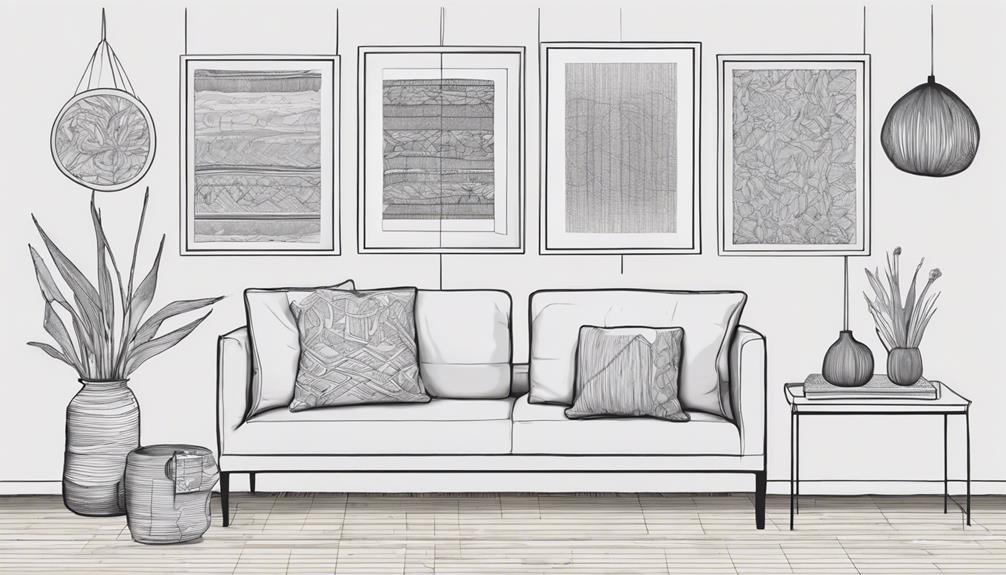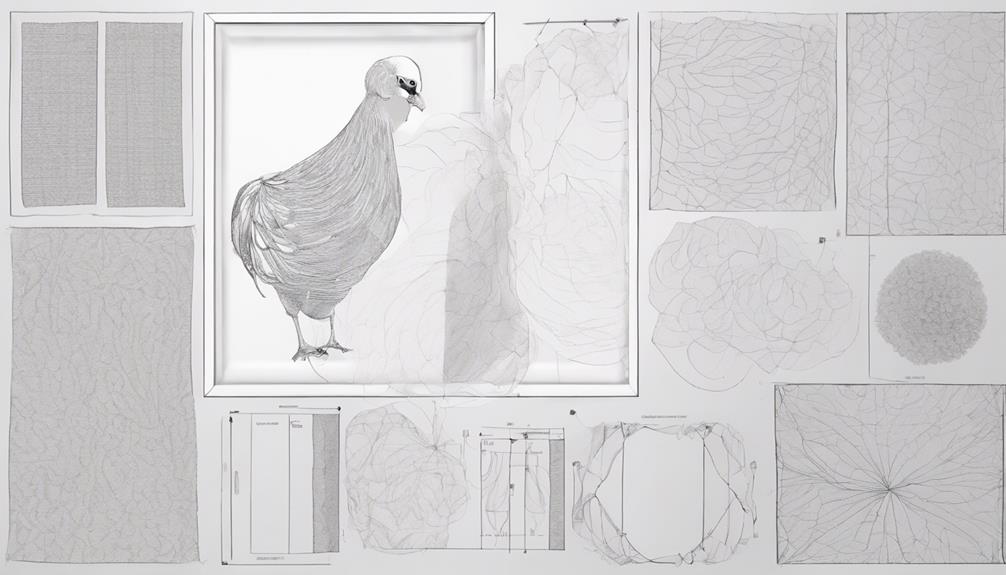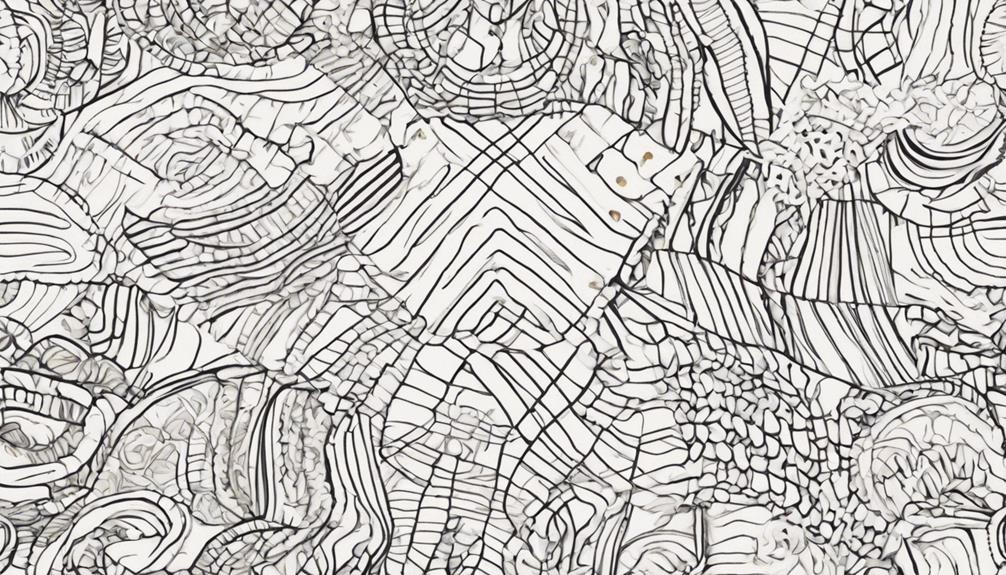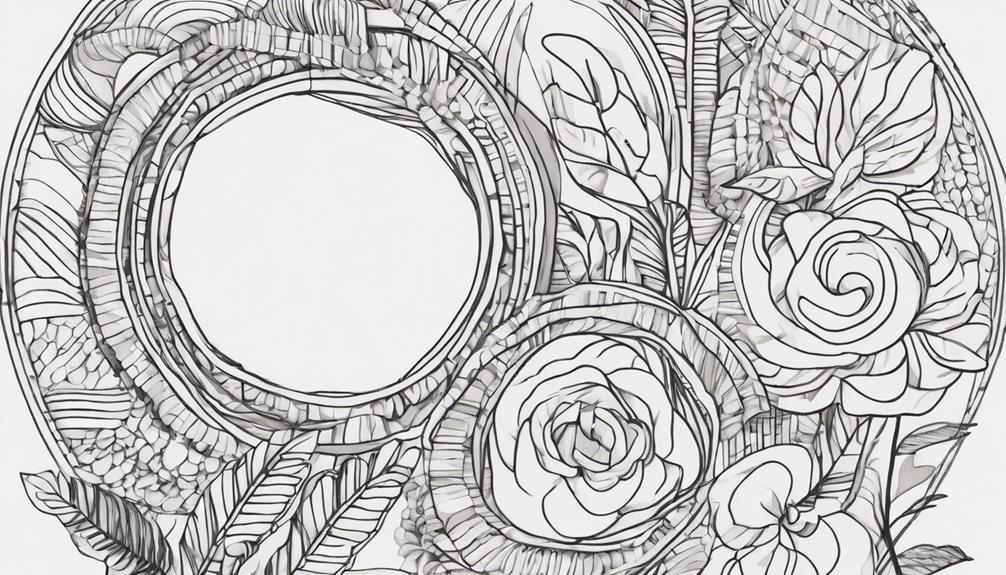Improve the attractiveness of your textile art by skillfully showcasing it, emphasizing intricate details, and maintaining its beauty. Discover fresh approaches to elevate your projects and safeguard their fine elements, ensuring a polished presentation. Familiarize yourself with various methods such as secure hanging with dowel rods and stable sewn sleeves. Recognize the profound cultural importance and symbolism of artisanal embroidery, enriching the significance of your artwork. Present a range of textile collections that exhibit meticulous craftsmanship and meaningful designs. Enhance your exhibition with effective mounting strategies, distributing weight evenly and utilizing diverse techniques for visual impact. Uncover inspiration and possibilities for collaboration within the lively textile art community.
Key Takeaways
- Utilize creative methods like unique hanging techniques and secure dowel rods for an elevated display.
- Sew stable fabric sleeves for safe hanging to protect delicate pieces.
- Showcase artisan embroidery with intricate designs reflecting cultural significance.
- Incorporate rich symbolism in textile art to tell stories and convey cultural meanings.
- Experiment with effective mounting strategies like box framing and float mounts for visual impact.
Framing Textile Art Professionally
To display your textile art professionally, framing it's vital for enhancing its presentation and protection. Framing textile art not only offers a polished finish but also safeguards delicate pieces from potential damage.
The framed pieces aren't only aesthetically pleasing but also easier to hang, transport, and store, making them more convenient for collectors to handle.
Exhibiting framed textile art is a breeze, as installation is quick and efficient, adding to the accessibility of the artwork. Additionally, framing adds a layer of intrigue and perceived value to the textile pieces, making them more appealing and marketable to potential buyers.
Creative Textile Display Methods

You can elevate your textile art display by hanging textiles safely, using dowel rods, or sewing a sleeve for hanging. These creative methods offer unique ways to showcase your textile pieces with style and versatility.
Experimenting with different display techniques can enhance the visual impact of your textile art collection.
Hanging Textile Safely
Secure your textile art by following these innovative hanging methods to ensure it is safely and creatively displayed.
- Distribute weight evenly on hanging mechanisms to prevent harm to textiles.
- Avoid using nails or metal pins directly on textiles to preserve their integrity.
- Consider using a dowel rod for lightweight textiles to guarantee stable hanging.
- Sewing a sleeve of cotton fabric to the back of the textile can provide a secure hanging option.
- Confirm the textile is strong and stable before hanging to avoid accidents or damage.
Using Dowel Rods
Consider incorporating dowel rods as a creative and secure method for displaying lightweight textile art pieces. Dowel rods can be sewn directly onto the textile using white or undyed cotton thread, ensuring stable hanging.
While not commonly seen in art galleries, dowel rods are effective in distributing weight evenly across the fabric. To prevent distortion and damage to fragile textiles, exercise caution in selecting the appropriate wood material.
Despite their simplicity, dowel rods offer a practical DIY solution for securely displaying textile wall art. For added stability, sewing a sleeve of cotton fabric to insert the dowel rod can provide a secure hanging option that minimizes the risk of harm to the artwork.
Sewing Sleeve for Hanging
To expand on creatively showcasing textile art, sewing a sleeve for hanging provides a practical and secure method for distributing weight evenly across the fabric. This technique involves sewing a sleeve crafted from cotton fabric onto the back of the textile, ensuring stability and preventing distortion of the artwork over time.
Here are some key points to bear in mind when utilizing this method:
- Distributes weight evenly, safeguarding the textile's integrity.
- Utilizes a sleeve crafted from cotton fabric for stability.
- Not recommended for heavy fabrics such as rugs or tapestries.
- Regularly inspect metal or plastic curtain rods for safety.
- Provides a straightforward and efficient way to securely hang textiles without causing damage.
Textile Collection Showcases

You can admire the intricate artisan embroidery techniques showcased in textile collections like Blue San Juan Comalapa II and Cream Nahuala IX, highlighting the skilled craftsmanship behind each piece.
Additionally, explore the rich symbolism infused in textile art, as seen in Rising Phoenix IV and Geometric Chichicastenango XXI, where cultural meanings and traditions are woven into vibrant patterns and colors.
These textile collection showcases offer a glimpse into the diverse and fascinating world of textile art, inviting viewers to appreciate the beauty and cultural significance of each piece.
Showcase Textile Art
Admire the exquisite textile collection showcases featuring a variety of styles and cultures. If you're looking to display textile art in a mesmerizing way, consider the following ideas:
- House Crush: Umberto Pastis House in Morocco offers stunning displays of textile art that will captivate any viewer.
- Explore ethical luxury by incorporating upcycled textile cushions into your showcase for a unique and sustainable touch.
- Discover diverse textile art collections like Blue San Juan Comalapa II and Cream Nahuala IX, each telling a unique story through fabric and design.
- Immerse yourself in the vibrant cultural heritage of Indonesia by showcasing intricate Ikat textiles that exhibit traditional craftsmanship and beauty.
- Admire the detailed Kutch embroidery from Gujarat, India, in stunning textile displays that highlight the skill and artistry of this ancient technique.
Artisan Embroidery Techniques
Artisan embroidery techniques exhibit intricate hand-stitched designs incorporating mirrors and complex patterns, highlighting the meticulous craftsmanship of skilled textile artisans.
These techniques are particularly evident in the work of Otomi natives from Tenango de Doria in Mexico, who create stunning handmade embroideries on various fabrics like linen, silk, and cotton.
The traditional embroidery produced by these artisans is a labor-intensive process, often taking weeks to months to complete a single piece.
The embroidery from Tenango not only showcases technical skill but also carries deep cultural significance. The symbolism within these textiles reflects the traditions and beliefs of the Otomi people, emphasizing harmony with nature.
Through their art, these artisans depict animals and plants inspired by memories and dreams, creating pieces that aren't only visually enchanting but also rich in cultural heritage and storytelling.
Symbolism in Textile Art
Symbolism in textile art shines through various cultural showcases, revealing intricate designs and meanings embedded in the fabrics. Explore the rich world of global textiles where symbolism plays a central role:
- Otomi natives of Tenango de Doria embroider textiles with symbolism reflecting traditions and beliefs in harmony with nature.
- Kuba textiles from the Congo feature intricate embroidery, appliques, and dyeing techniques rich in cultural symbolism.
- Indonesian ikat textiles showcase symbolic designs created through 42 intricate processes using natural ingredients.
- Peruvian sheep wool fabrics depict fauna and flora inspired designs, embodying cultural symbolism in intricate weaving.
- Indian Kutch embroidery showcases colorful patterns with intricate designs and small mirrors, reflecting traditional symbolism in textile art.
These diverse textile traditions demonstrate how symbolism can be intricately woven into fabrics, telling stories of culture, heritage, and beliefs through stunning designs.
Textile Art Conservation Techniques

To effectively preserve and protect textile art pieces, implementing proper conservation techniques is imperative. Framing textile art using acid-free materials is a fundamental step in safeguarding it from deterioration. Acid-free materials help prevent damage caused by acids that can be present in regular framing materials over time. Proper mounting techniques are also crucial for textile art conservation, as using archival materials can shield the artwork from environmental factors that may degrade it. Glass framing further protects textile art by acting as a barrier against dust and smoke, thereby maintaining its condition for longer periods. Additionally, utilizing acid-free mounting foam board in the framing process can significantly contribute to preventing deterioration and ensuring the longevity of the textile art pieces.
| Conservation Techniques | Description | Importance |
|---|---|---|
| Framing with Acid-Free Materials | Utilizing acid-free materials in framing helps prevent damage from acids over time. | Prevents deterioration |
| Proper Mounting Techniques | Using archival materials in mounting protects textiles from environmental factors. | Shields art from degradation |
| Glass Framing | Acts as a barrier against dust and smoke, maintaining the condition of the artwork. | Preserves art quality |
| Acid-Free Mounting Foam Board | Prevents deterioration and ensures the longevity of textile art pieces. | Essential for artwork preservation |
Effective Hanging Strategies

Implementing effective hanging strategies is crucial for preserving and showcasing textile art pieces. When it comes to displaying your textile art, there are several key strategies to keep in mind:
- Distribute weight evenly: Guarantee that the weight of the textile is evenly distributed on the hanging mechanism to prevent any damage to the fabric over time.
- Avoid nails or metal pins: Refrain from using nails or metal pins directly on the textile to maintain its integrity and prevent any tears or distortions.
- Consider dowel rods: For lightweight textiles, using a dowel rod can provide a stable hanging option that's gentle on the fabric.
- Sew a cotton fabric sleeve: Sewing a sleeve of cotton fabric onto the back of the textile can offer a more secure hanging method while also protecting the piece.
- Check stability: Before hanging your textile art, make sure the piece is strong and stable to prevent any accidents or damage during display.
Mounting Techniques for Textile Art
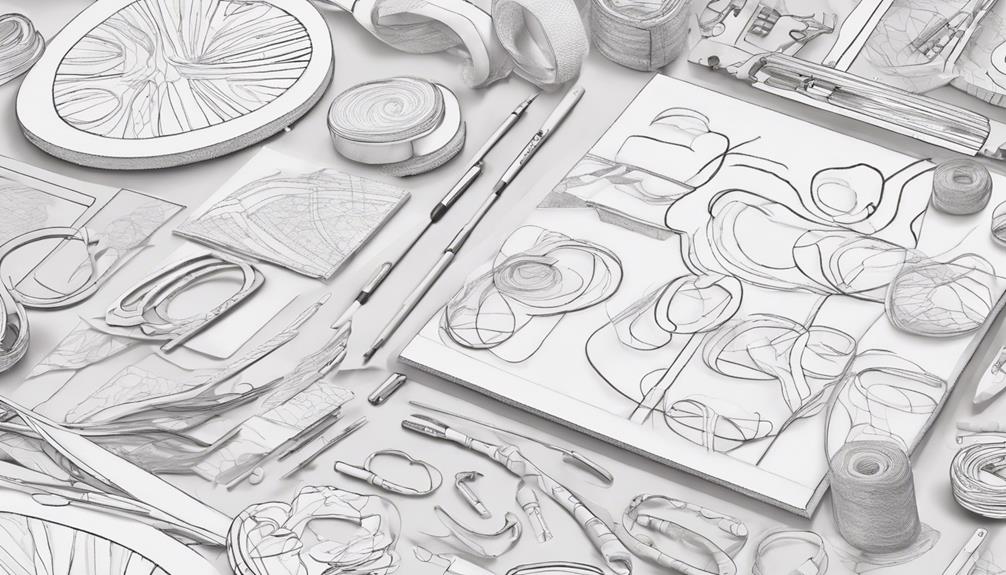
When considering mounting techniques for textile art, exploring options like using blank canvases, foam core, or canvas wraps can provide a clean and professional display for your pieces. Box framing offers a sense of depth and a floating effect, adding a touch of elegance to your mounted textile art.
Exhibitions often showcase the versatility and creativity of different mounting methods, demonstrating how the right technique can enhance the overall presentation of a piece of textile art.
Utilizing float mounts on mat boards after the batik process can further elevate the visual impact of textile art, drawing attention to intricate details and textures. For a unique display, consider using shadow box frames or electrical cable housing to provide support while also adding a distinctive touch to your mounted textile art pieces.
These techniques not only secure your artwork effectively but also contribute to the aesthetic appeal of your display.
Community Engagement in Textile Art

Joining online platforms like TextileArtist.org can enhance your engagement within the textile art community. By becoming part of this vibrant online space, you can connect with fellow artists, access valuable resources, and stay informed about the latest events and opportunities in the textile art world.
Here are some key ways community engagement in textile art can benefit you:
- Signing up for newsletters keeps you updated on events, workshops, and opportunities.
- Testimonials from artists highlight the supportive and informative nature of the online community.
- TextileArtist.org offers valuable content and resources for enhancing your skills and connecting with like-minded individuals.
- Engaging with the textile art community can provide inspiration and collaboration opportunities.
- Being part of this community fosters a sense of belonging and camaraderie among artists, creating a supportive environment for growth and creativity.
Frequently Asked Questions
How Do You Display Fabric Art?
To display fabric art, consider various methods like framing, mounting on canvas, hanging from rods, or using textile display ladders.
Securely hang fabric art using techniques such as dowel rods, sewing sleeves, or Velcro fasteners. Try rug hangers with tensioning devices to evenly distribute weight without holes.
Framing fabric art enhances presentation, preservation, and ease of hanging, transportation, and storage. Evolution in framing techniques caters to professional presentation, consumer preferences, and practicality.
How to Hang Textile Art on a Wall?
To hang textile art on a wall, it is important to distribute weight evenly on hanging mechanisms to avoid damage. Avoid using nails or metal pins directly on textiles. Consider using a dowel rod for lightweight textiles or sewing a sleeve of cotton fabric to the back for stability.
Velcro fasteners work well for heavy textiles, providing easy hanging and removal options. These methods preserve the integrity of your textile art while showcasing it beautifully on your wall.
How to Display a Huipil?
To exhibit a huipil, you can frame it in a shadow box to protect its delicate embroidery. Mount it on acid-free backboard to prevent damage.
Hang it on a decorative rod with hooks for a visually appealing look. Mount it on fabric-covered canvas for a textured display.
Use a curved textile display rod to let it drape elegantly. These methods will showcase the intricate design and guarantee longevity.
What Is the Textile Art Technique?
To understand the textile art technique, explore a diverse array like Otomi embroidery, Ikat, Kutch embroidery, or Peruvian handmade wool fabrics. Each method involves intricate processes and cultural significance.
From Indonesia to India, these techniques showcase rich histories and skilled craftsmanship. Immerse yourself in the world of textile art to appreciate the creativity and dedication behind each unique piece.
Conclusion
Now that you have learned how to display textile art in beautiful ways, remember that framing your pieces professionally can make a big impact.
Did you know that using creative display methods can increase engagement with your textile art by up to 50%?
So go ahead and showcase your collection with confidence, knowing that you're showcasing your art in the best possible light.

